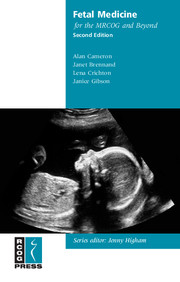Book contents
- Frontmatter
- Contents
- Preface
- Abbreviations
- 1 Screening for chromosomal abnormalities
- 2 Prenatal diagnostic techniques
- 3 The routine anomaly scan
- 4 Fetal structural abnormalities
- 5 Fetal therapy
- 6 Prenatal diagnosis and management of non-immune hydrops fetalis
- 7 Termination of pregnancy for fetal abnormality
- 8 Fetal growth restriction
- 9 Twin pregnancy
- 10 Fetal infection
- Index
7 - Termination of pregnancy for fetal abnormality
Published online by Cambridge University Press: 05 August 2014
- Frontmatter
- Contents
- Preface
- Abbreviations
- 1 Screening for chromosomal abnormalities
- 2 Prenatal diagnostic techniques
- 3 The routine anomaly scan
- 4 Fetal structural abnormalities
- 5 Fetal therapy
- 6 Prenatal diagnosis and management of non-immune hydrops fetalis
- 7 Termination of pregnancy for fetal abnormality
- 8 Fetal growth restriction
- 9 Twin pregnancy
- 10 Fetal infection
- Index
Summary
Introduction
The United Kingdom Abortion Act was passed in 1967 and amended in 1990 when the Human Fertilisation and Embryology Act was passed. The main changes were that an upper time limit of 24 weeks was introduced for the termination of pregnancy where fetal abnormality was not the indication for the procedure. There was also the removal of any time limit if a termination was being carried out for fetal abnormality, such that no offence was committed under either the law relating to abortion or the Infant Life Preservation Act 1929 if a medical practitioner was involved within the clauses of the Abortion Act in this work.
The main clause concerning termination for fetal abnormality is found in Section I(d) of the Act and this states that termination is permitted when two registered medical practitioners are of an opinion formed in good faith that ‘there is substantial risk that if the child were born it would suffer from such physical or mental abnormalities as to be seriously handicapped’.
This, therefore, forms the basis of legal termination of pregnancy for fetal abnormality in the UK. The stage of pregnancy at which the diagnosis is made and the time of pregnancy when the decision to perform a termination is made are crucial in terms of how the procedure may be performed. The decision to terminate a pregnancy because of fetal abnormality is often extremely difficult and it is vital that a comprehensive counselling service is available to the couple concerned before undertaking the procedure. This should involve multidisciplinary teamwork from obstetricians, midwives, geneticists and paediatricians, where appropriate. This complex area is dealt with in detail by Fisher and Staham.
- Type
- Chapter
- Information
- Fetal Medicine for the MRCOG and Beyond , pp. 125 - 134Publisher: Cambridge University PressPrint publication year: 2011



